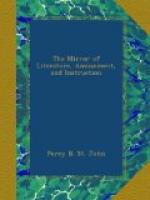The several species of herons may not improperly be ranked among the platform builders; for though they construct a shallow depression in the centre of the nest, which is by all the species, if we mistake not, lined with some sort of soft material, such as dry grass, rushes, feathers, or wool, the body of the nest is quite flat, and formed much in the manner of an eagle’s eyry, of sticks crossing one another, and supported upon the branches or between the forks of high trees. All the species also are social, nestling in large communities, after the manner of rooks; though instances are not uncommon of individual pairs breeding solitary. Belon tells us, that “the heron is royal meat, on which the French nobility set great value;” and he mentions it as one of the extraordinary feats performed by the “divine king,” Francis I., that he formed two artificial heronries at Fontainbleau;—“the very elements themselves,” he adds, “obeying the commands of this divine king (whom God absolve!); for, to force nature, is a work partaking of divinity!"[5] In order to enhance the merit of these French heronries, he undertakes to assert that they were unknown to the ancients, because they are not mentioned in any of their writings; and for the same reason, he concludes that there are none in Britain. Before Belon’s time, on the contrary, and before the “divine” constructor of heronries in France was born, there were express laws enacted in England for the protection of herons, it being a fine of ten shillings to take the young out of the nests,[6] and six shillings and eightpence for a person, without his own grounds, killing a heron, except by hawking or by the long-bow;[7] while, in subsequent enactments, the latter penalty was increased to twenty shillings, or three months’ imprisonment.[8] At present, however, in consequence of the discontinuance of hawking, little attention is paid to the protection of heronries. Not to know a hawk from a heronshaw (the former name for a heron) was an old adage, which arose when the diversion of heron-hawking was in high fashion. It has since been corrupted into the absurd vulgar proverb, “not to know a hawk from a handsaw!"[9] The flesh of the heron is now looked upon as of little value, and rarely if ever brought to market, though formerly a heron was estimated at thrice the value of a goose, and six times the price of a partridge.[10]
[5] Oiseaux, p 189. [6] 19 Henry VII. c. 11. [7] Ibid. [8] I James, c. 27, s. 2. [9] Pennant, Brit. Zool. ii. 341. [10] Northumberland Household Book, p. 104.
The heronries recorded to be existing at present in this country are in Windsor Great Park, on the borders of Bagshot Heath; at Penshurst-place, Kent; at Hutton, the seat of Mr. Bethel, near Beverley, in Yorkshire; at Pixton, the seat of Lord Carnarvon; in Gobay Park, on the road to Penrith, near a rocky pass called Yew Crag, on the north side of the romantic lake of Ulswater; at Cressi Hall, six miles from Spalding, in Lincolnshire;




